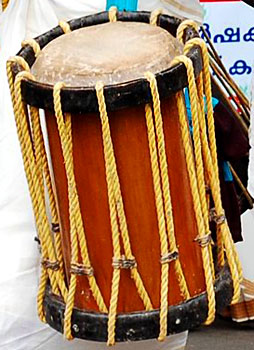 Chenda is a kind of drum used as a percussion instrument in the state of Kerala. This is found also in Karnataka, as the Chende, but it has not developed that strong social association as the Chenda in the Malayalam area. Though the structure of the Chenda is not as refined as some of the other classes of drums such as the Pakhavaj, Mridanga or Tabla, it is the superiority of the playing technique, especially the rhythmic elaboration called Tayambakam, which sets this instrument apart.
Chenda is a kind of drum used as a percussion instrument in the state of Kerala. This is found also in Karnataka, as the Chende, but it has not developed that strong social association as the Chenda in the Malayalam area. Though the structure of the Chenda is not as refined as some of the other classes of drums such as the Pakhavaj, Mridanga or Tabla, it is the superiority of the playing technique, especially the rhythmic elaboration called Tayambakam, which sets this instrument apart.
The instrument has a cylindrical body usually made of Jackwood. It is about 50 cms length and 25 in diameter. The leather which is used for making the faces is of heifer. One side, called the left side, is a single plain parchment. However, the other side, called the right side, is a complex set of hides, six or seven in number, of decreasing diameter, glued on one another. The leather is held by a bamboo or metal hoop and the hoops on either side are connected by rope braces. The drum is suspended from the neck of the player who plays it with a pair of sticks. Though both sides can be used for playing, only one is actually beaten. Using the pair of sticks the drummer strikes only the upper parchment.
There is a variety of Chendas, Acchan-Chenda, Veekku-Chenda, Uruttu-Chenda, Muri-Chenda and so on, differing in size, structure, and function. The instrument is one of the most versatile drums of this area. The Chenda is most often used for performance in Hindu temple festivals and as an accompaniment in the various religious art forms of the state. It is used in the dance ensemble of Kathakali, Kriyanga Pancha Vadyam or the ritual instrumental groups of temples, Chenda Melam or an assemblage of rhythmic instruments. The drum is considered as an Asura Vadyam (demonic instrument) and normally only its left side is played, the right side being struck on specific occasions as, for instance, when the deity is brought on to the arena in Kathakali dance or in the Tantric rituals connected with the worship of Goddess Bhadrakali.




